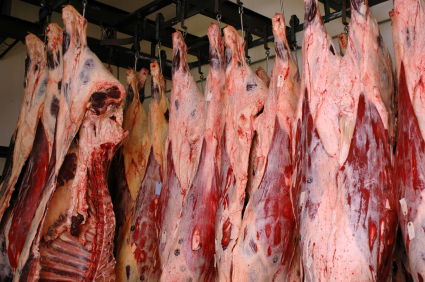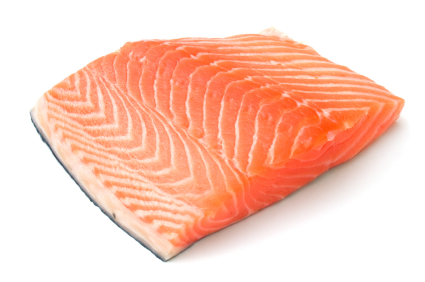 Down on the farm: most salmon consumed in the U.S. comes from aquacultureIn a post on his group blog, the Internet Food Association, Washington Post blogger and food-politics columnist Ezra Klein poses the philosophical question, “Is the Cheesecake Factory Gross?”
Down on the farm: most salmon consumed in the U.S. comes from aquacultureIn a post on his group blog, the Internet Food Association, Washington Post blogger and food-politics columnist Ezra Klein poses the philosophical question, “Is the Cheesecake Factory Gross?”
The context is a bet involving the highly regarded cookbook writer Michael Ruhlman, who recently chided another writer for praising a dish offered by the Cheesecake Factory called “miso salmon.” (By the way, when did cheesecake factories start churning out fish dishes? Are salmon farms going to start whipping up cheesecakes?)
Accepting a challenge from the Cheesecake Factory-loving writer, Ruhlman sampled said miso salmon–and reluctantly admitted to finding it “delicious.” He also praised something called “crispy beef,” and found the restaurant’s “chicken piccata” and “pasta carbonara” solid but uninspired. Ruhlman’s conclusion: The Cheesecake Factory is depressingly mid-brow, but it doesn’t suck after all.
For Klein, Ruhlman’s judgment settles the debate around whether Cheesecake Factory is gross. Klein continues with a nice discussion of how gigantic companies have the resources to make food taste good, and then fixates on the alarmingly high caloric content of the chain’s wares.
All of this is well and good–but it doesn’t really get to the heart of whether or not the Cheesecake Factory is gross. “The food is enjoyable,” Klein declares. “The value is incredible.” Now if only the company would cut down on portion size/calories, it would be great. Right?
No. To gauge the Cheesecake Factory’s grossness or lack thereof, you have to go beyond the assessment of a celebrated gourmand or calorie counts. Here’s my question: What sort of ingredients is the company using?
The company’s menu fills pages like a 19th century Russian novelist. It contains this “promise“:
We use all-natural chicken, humanely raised without the use of antibiotics or unnecessary chemicals, premium beef that is Certified Angus, U.S.D.A. Kobe or Choice, fresh fish that is either Longline or Hook & Line caught whenever possible, cooking oils that contain no trans fats, and much of our produce is sourced direct from premium growers.
That’s more than you get from lots of restaurant chains, but really says nothing about whether the meat and fish it serves is factory-farmed. Let’s go back to that miso salmon. The menu describes it thusly: “Fresh Salmon Marinated in Miso and Baked. Served with a Delicious Miso Sauce, Snow Peas and White Rice.”
Now, corporate restaurants exist to maximize profit. The Cheescake Factory is going to use the cheapest ingredients its customers will let it get away with. And if it were to use a pricier alternative to industrial ingredients–say, wild salmon, grass-fed beef, pasture-raised poultry or pork–you can be sure you’d hear about it on the menu (along with a premium in the price tag).
So I think it’s pretty safe to assume the salmon in the dish Ruhlman praised–like 90 percent of salmon consumed in the U.S.– is factory-farmed. And factory-farmed salmon is pretty, well, gross stuff. Where to start?
In a recent Huffington Post article, the respected sustainable-ag writer Dan Imhoff reported that Chile’s massive salmon farms–about a third of whose output ends up in the U.S.–are “on the verge of collapse.” Here’s how Imhoff describes the industry:
Salmon are not indigenous to Chile, but grown in crowded cages installed in the bays and estuaries of the country’s otherwise beautiful southern fjord region. These “farmed” Atlantic salmon are fed a steady diet of wild fish–perfectly edible for humans, but more profitable when converted into “value-added” finfish. The approximately three pounds of wild fish needed to produce each pound of farmed salmon has caused some people to refer to finfish aquaculture operations as “reverse protein factories.” Equally alarming, salmon farms have become excessively dependent upon toxic pesticides to combat sea lice and antibiotic medicines to thwart viruses that can run rampant among the high concentrations of rapidly growing, penned fish–not unlike industrial-scale hog, poultry, and cattle CAFOs on land.
And as Imhoff reports, the pesticides are no longer working: “According to industry source Intrafish, Chile’s 2009 salmon output could decline by as much as 87 percent from last year–a drop from 279,000 metric tons in 2008 to between 37,000 metric tons and 67,000 metric tons.” If and when the Chile salmon industry does collapse, it will leave behind a legacy of ecological and social ruin–fishing and farming communities displaced for ephemeral low-paying jobs, once-productive waterways polluted and abandoned.
Mind you, Chile is the globe’s second most prodigious source of farmed salmon, after Norway. That country’s salmon industry is no day at the beach, either. In his 2008 book Bottomfeeder (must reading for all food politics columnists), Taras Grescoe shows that three enormous Norwegian firms dominate North American salmon farming.
Grescoe documents how these massive operations are snuffing out Washington State’s celebrated wild-salmon fishery. The situation is so dire, and the economic benefits of salmon factories are so thin, that Grescoe can find no good reason why Washington officials allow the Norwegian firms to have their way with the shoreline. In the end, he can only speculate that real estate interests are behind the puzzling policy. Prime acres of river-front land are now prohibited from development to protect the salmon run. Let the salmon die, and the rationale for development limits vanishes.
At any rate, it’s well-documented that salmon factories spell doom for nearby wild-salmon fisheries. A 2007 Science article doesn’t mince words:
We show that recurrent louse infestations of wild juvenile pink salmon (Oncorhynchus gorbuscha), all associated with salmon farms, have depressed wild pink salmon populations and placed them on a trajectory toward rapid local extinction.
By 2003, 70 percent of salmon produced in Washington and British Columbia came from farms. A highly productive and energy-efficient source of fabulously delicious and nutritious food is being sacrificed to churn out a vapid and suspect product.
Suspect? Yes. Let’s look at the PCB issue. In a 2004 Science paper, researchers stated that “the potential human health risks of farmed salmon consumption have not been examined rigorously” (this, even though “annual global production of farmed salmon has increased by a factor of 40 during the past two decades.”) What happened when a rigorous study finally took place?
We show that concentrations of these contaminants are significantly higher in farmed salmon than in wild.
The researchers conclude: “Risk analysis indicates that consumption of farmed Atlantic salmon may pose health risks that detract from the beneficial effects of fish consumption.”
That’s pretty gross.
Now, while scanning the Cheesecake Factory’s listing of seafood offerings, I couldn’t help but notice that the chain offers no fewer than five shrimp dishes. Sigh.
“Today, 90 percent of our shrimp–more than 1 billion pounds a year–come from foreign farms,” writes Jim Carrier in an excellent recent piece in Orion. In Bottomfeeder, Grescoe puts it like this: “The simple fact is, if you’re eating cheap shrimp today, it almost certainly comes from a turbid, pesticide- and antibiotic-filled, virus-laden pond in the tropical climes of one of the world’s poorest nations.” Lest anyone think otherwise, these factory farms generate poverty in the nations that house them, as Grescoe demonstrates; they privatize and cut down highly productive mangrove forests that once sustained fishing communities, leaving fetid dead zones in their wake.
So, unless Cheesecake Factory is using rarefied ingredients for dishes like shrimp scampi and miso salmon–let’s ignore, for now, the factory-farmed meat or the likely source of winter-season tomatoes–it’s pretty damned gross, I’d say. Of course, it’s gross in a banal, everyday way: the way that our entire food-production system has us eating gross shit, all the time. Avoiding it takes lots of work; the path of least resistance leads to a gleaming Cheesecake Factory, standing alone at the edge of a strip mall. Fixing the situation won’t be easy; but it starts with calling it what it is.
Now, one brief note on Ezra’s fixation on calorie counts and obesity: There’s a growing literature suggesting a link between exposure to food-based toxic pollutants like PCBs and obesity/diabetes. See here, here, here, and here.




